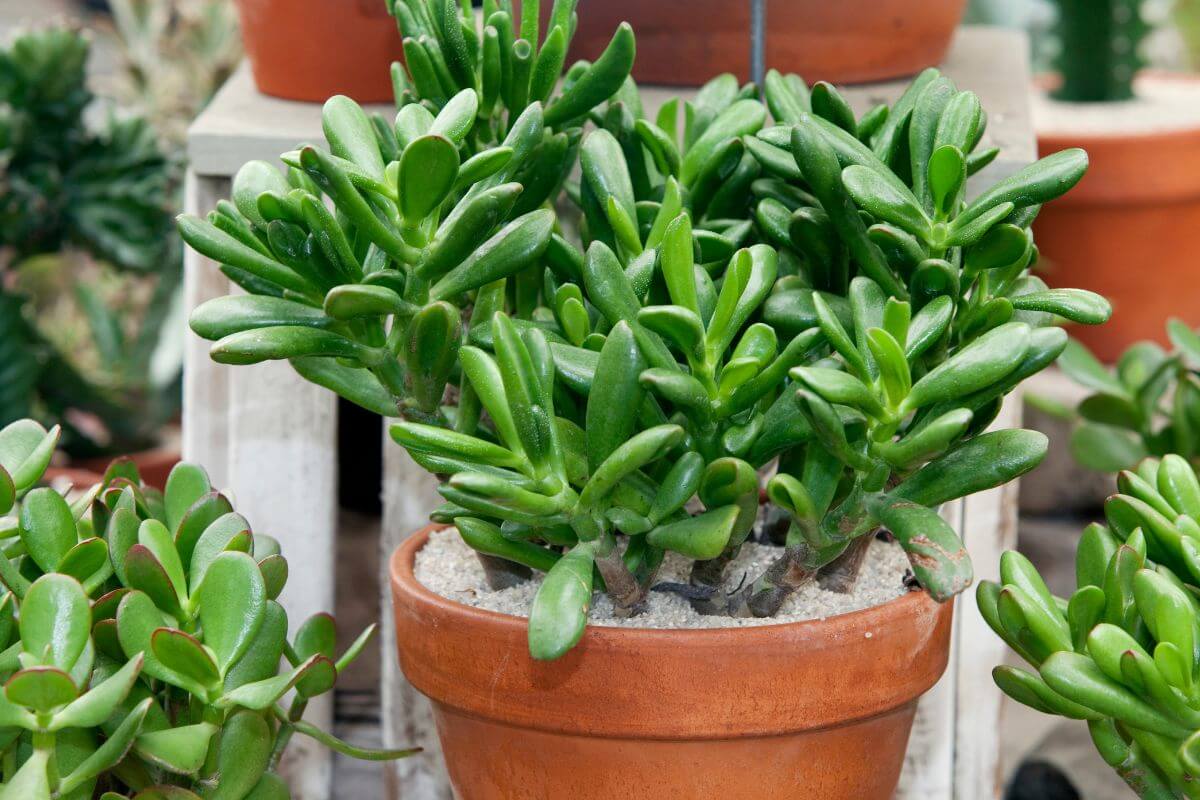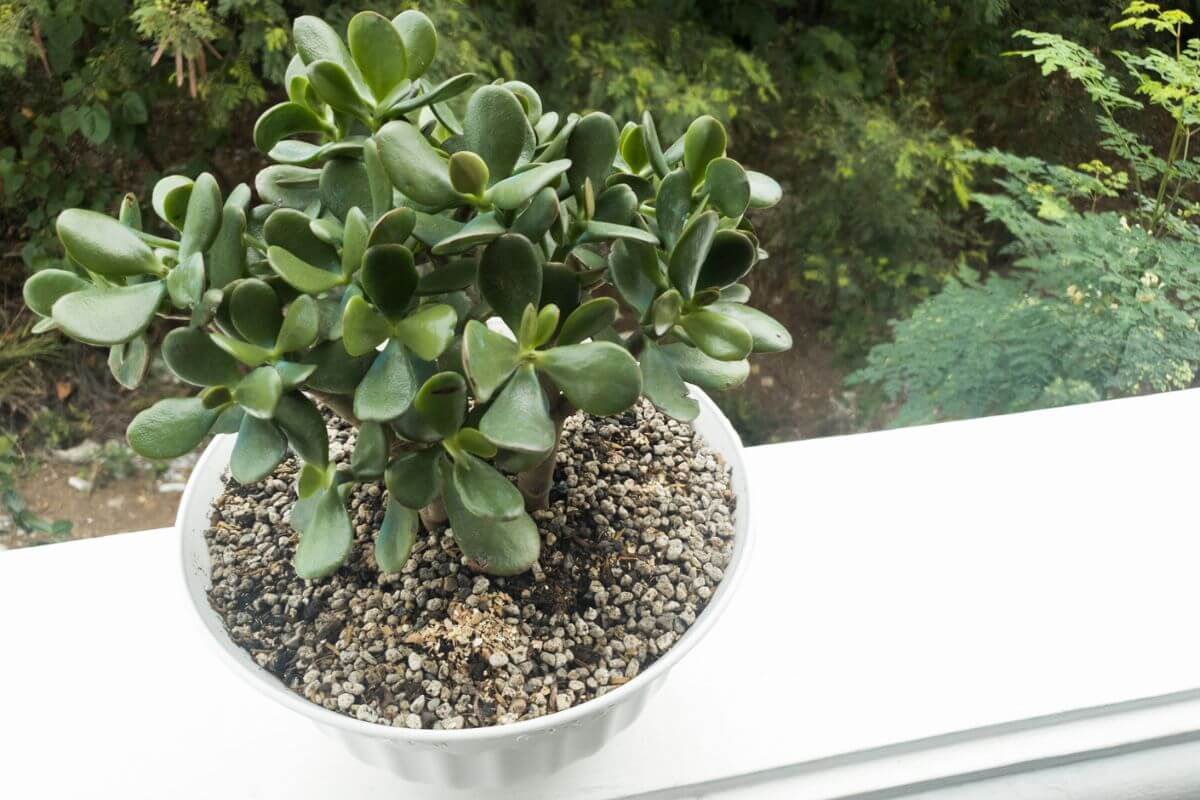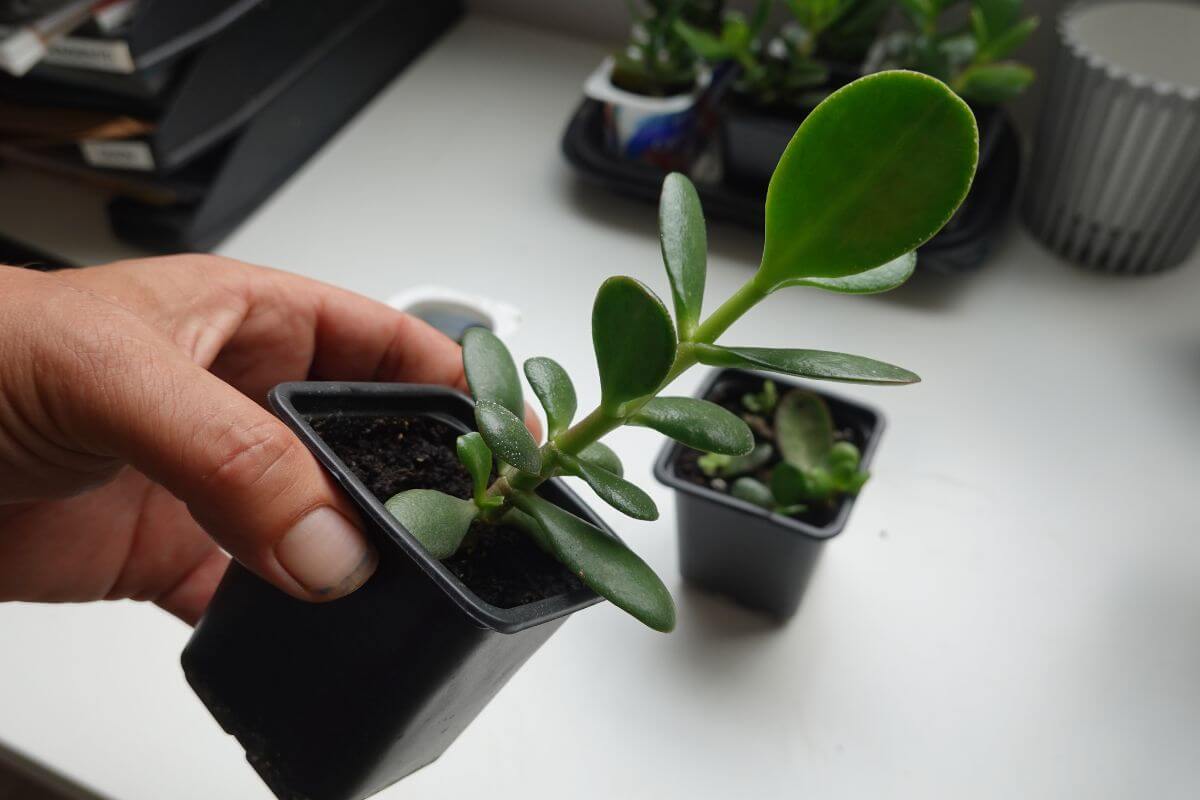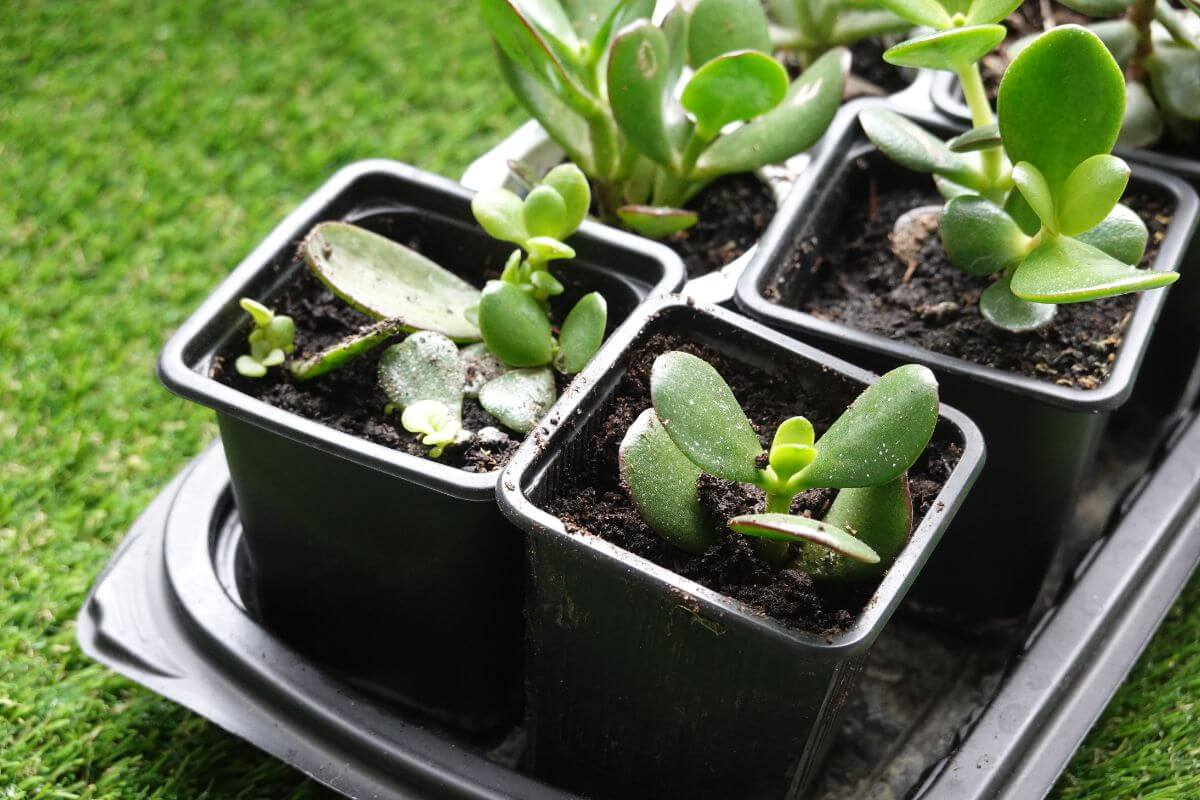“Jade by the door, poor no more!”
Jade plants, with their thick, shiny leaves and strong stems, are like small green trees that bring a bit of nature into your home. It’s amazing how a plant can be so tough yet so beautiful!
In this guide, you’ll learn how to keep your jade plant healthy and happy. We’ll cover everything from the best soil and pots to their light and water needs. You’ll also find out about the different types of jade plants, how to grow new ones from cuttings, and how to protect them from pests.
Thinking about adding a jade plant to your home or taking better care of the one you have? Let’s find out and learn easy ways to keep them healthy. Whether you’re new to plants or have experience, there’s something here for everyone!
- Related article:
7 Key Takeaways on Jade Plants
- Jade plants are resilient, water-storing succulents native to South Africa, with over 150 species.
- They thrive in well-draining soil, preferably in clay pots to avoid excess moisture and prevent tipping.
- These plants love bright, indirect light but can tolerate some direct sunlight, especially when mature.
- Overwatering can cause root rot, so it’s important to let the soil dry out between waterings, especially in winter.
- Jade plants prefer average household temperatures, but should be protected from frost and extreme heat.
- Propagating jade plants is easy using leaf cuttings.
- Jade plants are toxic to pets and can attract pests like mealybugs, requiring regular checks for infestations.
What Is a Jade Plant?

A succulent houseplant that calls South Africa its first home, the jade plant is a member of the Crassula genus. There are at least approximately 150 species of Crassulas.
This plant goes by a number of names. The Crassula ovata or Crassula argentea is commonly known as the Jade Plant, Money plant, Lucky plant, Silver dollar plant, or Friendship plant.
The common jade plant resembles a miniature tree with its oval-shaped leaves and thick, woody stems that help to store water. Indoor plants will generally not blossom, but when outdoors, jade plants will produce small white flowers.
This plant is aesthetically appealing and pretty indestructible. They can be found worldwide whether in North American deserts, Mediterranean islands, or at home in Africa.
A mature plant can grow from three to six feet in height and from two to three feet wide. On mature plants, the stems will develop the appearance of small tree trunks. When outdoors, jade plants can appear to be small trees or bushes.
Different Jade Plant Varieties
Jade plants, come in many varieties. While the classic jade plant with thick green leaves is the most common, there are other types that have different colors and shapes. Some popular jade plant varieties include:
- Tricolor – This jade plant has pink flowers and variegated leaves in green, white, and pink shades.
- Sunset (Hummel’s Sunset) – The Sunset jade has yellow leaves with red tips, especially in bright light.
- Variegata – Variegated jade plants, like ‘Tricolor’ and ‘Variegata’, have yellow or ivory leaves with green streaks.
- Copper (Bronze Beauty) – Copper jade plants have green leaves with bronze or reddish-brown edges.
- Monstrose Hobbit – This type has curled, tube-like leaves with a yellow-green color. Its unique shape makes it stand out.
Learn more about the Different Types of Jade Plants.
How to Care for a Jade Plant
If you are interested in growing a Jade plant at home, you’re in luck! It’s easy to care for and can thrive with just a little attention. Here are some important things to know about keeping your Jade plant healthy and happy.
Jade Plant Soil Requirements

An ideal soil bed should be a potting mixture that is specifically blended for succulents. The soil should drain well to prevent an excess of water that can lead to fungal disease.
If you decide to use standard potting soil, perlite should be added to assist with proper drainage. Soil pH should be neutral to a bit acidic measuring between 6.1 and 6.5.
Also, avoid placing your plant in a plastic flower pot or container. A clay or terracotta container is better because it will help wick away extra, unwanted moisture in the soil.
Since these plants store water in their leaves, they will tend to be top-heavy. Clay pots also help prevent the plant from tipping over.
- Read more about Jade Plant Soil Options
Jade Plant Light Requirements
Jade plants love bright light. The plant should receive approximately six hours of bright ample sunlight daily. A south-facing window is great for that.
It is wise, however, to keep young plants away from direct sunlight and its UV rays as that may scorch the foliage and turn the leaves red.
Mature jade plants can absorb and even benefit from up to six hours of direct light occasionally, but indirect light is still preferred. Young jade houseplants like indirect sunlight, while mature plants can withstand direct sunlight.
If your jade plant becomes leggy, it’s a sign that they’re are not receiving enough light. Legginess comes from the plant trying to reach the little available light that it finds.
- Read more: How to Fix Leggy Jade Plants
Jade Plant Water and Humidity Requirements
Watering will be particularly important during the spring and summer months when the soil should be kept moist. During the winter, you can reduce your watering to once a month unless you live in dry conditions or your home is a consistently heated environment.
Drainage must be excellent at all times. If you water your plants by allowing them to sit in a saucer or bowl of water, eliminate any excess water when you are finished.
A jade plant must not sit in water for long periods of time as there’s a high risk of root rot. Overwatering is usually the culprit when a jade plant fails and is the leading cause of death.
The normal jade plant prefers low humidity, so there’s no need to add a humidifier to the maintenance of jade plants.
Jade Plant Temperature Requirements
Jade plants thrive in average household temperatures ranging from 65° to 70° Fahrenheit. At night, they appreciate cooler temperatures and likewise during the winter months.
They can manage quite well at 55° F, but these plants do not tolerate frost. If you are cultivating your plant outdoors, bring it inside if you can, should the temperature fall under 50°F.
While they will tolerate a dry environment, if a home or office is too hot, the plant will go dormant. Leaves will begin to drop. Do not let the soil bed dry out in these temperatures either.
Should your Jade be outside and the temperature reaches 90°F or more, the plant should be moved to a shady spot to prevent sunburn and leaf drops.
Jade Plant Fertilizer Requirements
A 20-20-20 balanced liquid fertilizer is optimal at a quarter strength. On young jade plants, use fertilizers that contain less nitrogen.
A fertilizer that features a controlled release at the beginning of the growing season is a good option. But you can also choose to feed your jade plant once a week with diluted liquid fertilizer.
Because of the fleshy leaves of many succulent plants, people tend to underfeed them. They should still be fed during their growing season.
How to Repot the Jade Plant

When to repot a money plant depends on the individual plants. These indoor plants are slow growers. They actually enjoy being crowded and generally do not need repotting to a large container every year. Repotting can also rejuvenate and revive a plant.
A good rule of thumb is to replace the soil about every three years as new growth starts. A good time to repot is the early summer when it is warm.
If you wish to use a larger container, select a pot that is no more than two sizes larger.
Here’s how to repot the jade plant:
- The plant’s original soil should be dry before you decide to repot.
- Lift your plant from the container gently.
- Remove any old soil from the roots, as well as dead roots. If you notice any cuts, treat them with a fungicide.
- Place new soil in a new container about a third full. Place the plant in the new container and spread the roots out.
- Fill in the container with new potting mix and cover the roots.
- Leave your newly potted plant dry for approximately a week before watering for the first time.
How to Propagate the Jade Plant
The Jade plant is one of the easiest plants to propagate. These plants can be propagated from one single leaf from your mother plant.
Here’s how to propagate your jade plant from leaf cuttings:
- Remove a leaf (or 2-3 inch cutting) from the parent plant and place it in a dry warm place for a few days.
- Once a small scab has formed over the cut point, plant the leaf or cutting in a container filled with cactus or succulent potting mix. The scab end should be placed in the soil bed.
- Place the container in a warm location with plenty of bright sunlight until roots form.
- Once the roots have formed and the plantlet appears well-rooted in its soil bed, water it well, and then care for it as you would any jade plant.
- These plants can also be divided at the roots and repotted in separate containers.
- Learn more about How to Propagate a Jade Plant
Are Jade Plants Toxic to Pets?
Unfortunately, the beautiful jade plant is toxic for dogs and cats. All parts of the plant are considered poisonous (source).
If the plant is ingested in very large quantities, it can be fatal. Should your pet exhibit any of the following symptoms, contact your veterinarian immediately.
Poisoning symptoms to watch for:
- Trouble moving or weak muscles
- Seeming very sad or down
- Sleeping a lot
- Being more aggressive than usual
- Very tired
- Throwing up
- Feeling weak
Jade Plant Pests, Diseases, Problems and More

Jade plants are subject to pest infestations and disease. Among pests, the most common to find its way to a Jade plant will be the mealybug. They will leave evidence of its presence through white patches on the plant, particularly where stems are attached to leaves.
Jade plants, cacti, and succulents, in general, are sensitive to pesticides as well as oils. If you find evidence of mealybugs on your plant, wipe off the plant with a cotton ball soaked in rubbing alcohol.
Occasionally, the Jade plant can fall victim to powdery mildew, scale insects or spider mites. These pests should be treated the same as mealybugs.
Overwatering or poorly draining soil can lead to root rot. Symptoms include leaves that drop off, soft stems, soft leaves, and mushy, brown-colored roots.
When you start seeing the symptoms for root rot, take action to rejuvenate the plant:
- Remove the plant from the soil.
- Allow the plant to dry in the open air for several days
- Repot when the roots are dry.
Jade Plant Care Final Thoughts
The Jade plant is an easy-to-care-for succulent. It’s great for anyone, whether you’re just starting out or you’ve been gardening for years. Its look is cool, like a mini tree, and there are lots of kinds to choose from.
Taking proper care of a Jade plant is also simple, but there are a few things you need to achieve a healthy Jade plant. It likes bright indirect light, a well-draining soil, and you don’t want to water it too much. One important thing to remember is that Jade plants aren’t safe for pets, so keep them out of reach.
If you do everything right, your Jade plant will live for a long time. It’ll make your home look nicer and bring good vibes.
Jade Plant Care FAQs
1. Does the Jade Plant Need Sunlight?
Yes! Jade plants need plenty of light. Place them near a window where they can get bright indirect sunlight for part of the day.
2. Is the Jade Plant an Indoor or Outdoor Plant?
Jade plants can thrive both indoors and outdoors. Just avoid extreme temperatures and high humidity, keeping them between 50°F and 90°F.
3. What Are the Benefits of a Jade Plant?
Jade plants are low-maintenance, improve air quality by absorbing toxins, and are believed to bring good luck and prosperity.
4. Are Coffee Grounds Good for Jade Plants?
Yes, coffee grounds help jade plants grow, but use them on the soil, not the leaves, to avoid damage.
5. Do Jade Plants Like Small Pots?
No, jade plants especially larger jade plants prefer larger pots that allow their roots to spread and absorb oxygen and moisture.
Check out these guides for other great houseplants to grow at home:





